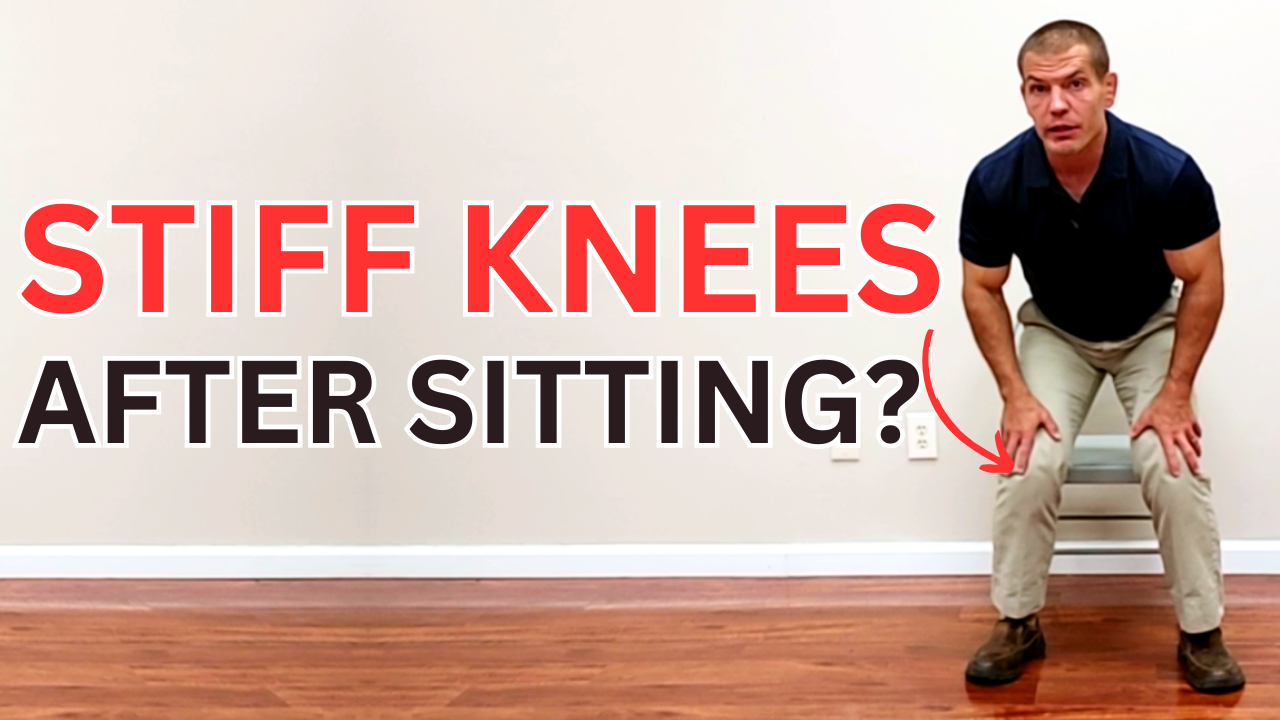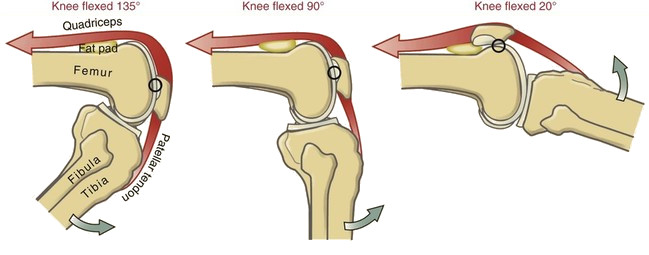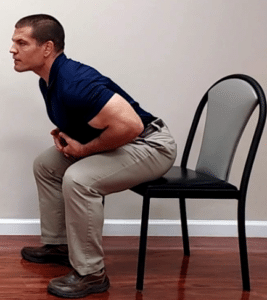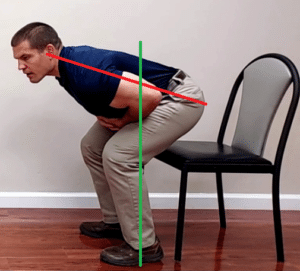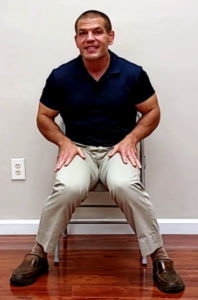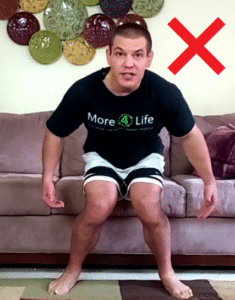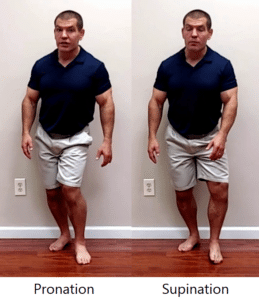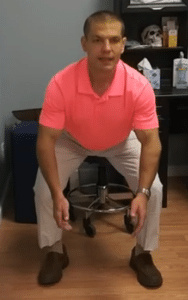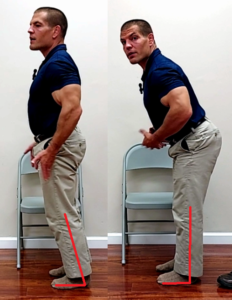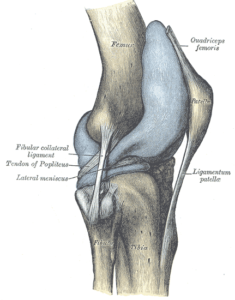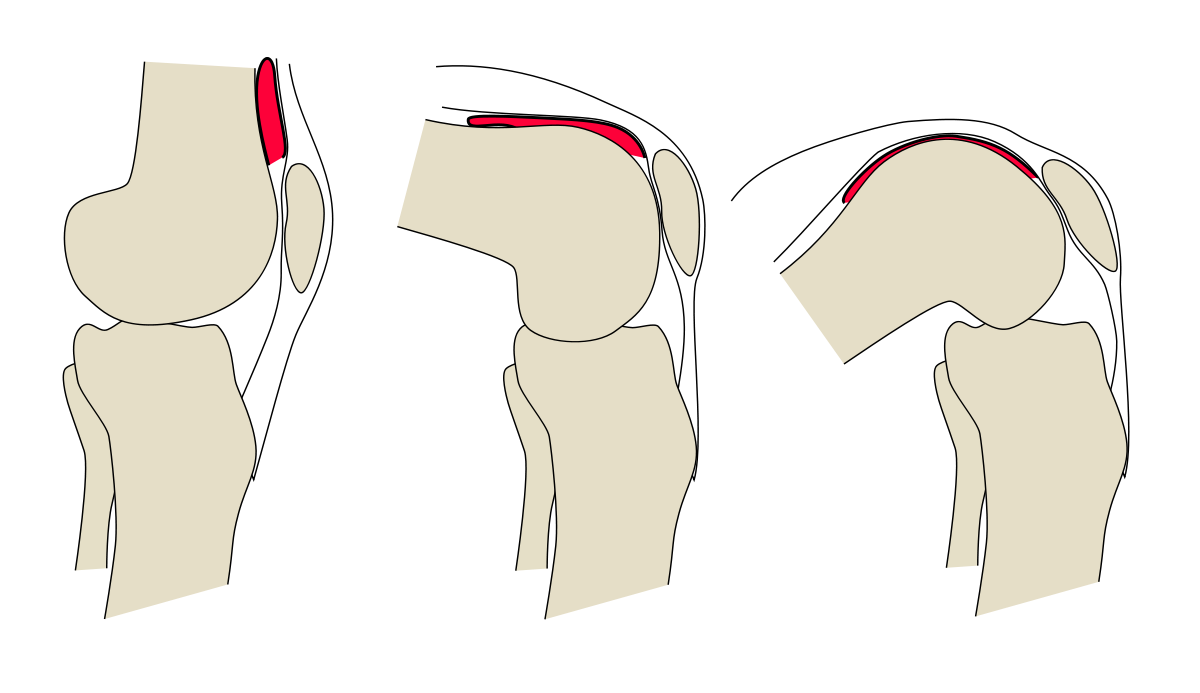Do Your Knees Feel Stiff After Sitting For A Long Time?
Maybe you have trouble standing up from a chair. Perhaps you feel like you have trouble straightening your knees out all the way when you first stand up.
Or maybe your legs just feel heavy and unsteady for those first couple of steps after standing.
If any of those apply, if you have knee stiffness after sitting, and you're tired of hearing that it's "just arthritis" and you're just going to "have to deal with it", then make sure to watch this video.
You'll learn what REALLY causes knee stiffness after sitting for long periods of time and how to stop it.
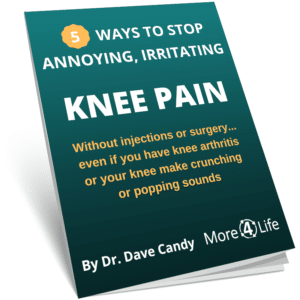
What Causes Knee Stiffness After Sitting?
The reason that knee stiffness is so hard to describe is that knee stiffness is kind of a subjective concept. There's no real good way to measure it.
Now, there is an objective engineering definition of stiffness:
The amount of force it takes to stretch an object by a certain length. For example how many pounds of force it takes to lengthen a muscle by 1 inch or how many pounds it takes to move a joint through 1 degree of motion.
However, that's not usually what patients describe when they talk about knee stiffness.
It's more of a feeling of just tightness or a mild pain or pressure.
So here are the three types of knee stiffness after sitting that I commonly hear about from patients.
3 Type Of Knee Stiffness After Sitting:
- Patellofemoral (Kneecap) Stiffness
- Knees feel weak, unsteady, or hard to straighten after sitting
- Knees feel swollen and heavy after sitting
Patellofemoral Knee Stiffness After Sitting
The first type of knee stiffness is stiffness underneath the kneecap. You may feel like when you're sitting for a long time that you need to straighten your knee a little bit because you've got pressure behind the kneecap.
Or you may have pain or difficulty standing up where you feel like a crunching or grinding your knees. You may even hear noises behind your kneecap when you first go to stand up.
That pressure behind the kneecap commonly happens in people with kneecap arthritis or a milder form called chondromalacia patella.
But there are people without those problems who also get front of knee stiffness after sitting for long periods.
Conversely, there are people with knee arthritis who don't get knee stiffness after sitting.
So what exactly is it that causes that stiffness or pressure behind the kneecap when you're sitting for a long period of time?
To understand that, you kind of have to understand a little bit about how the kneecap joint (patellofemoral joint) is formed. (patella = kneecap, femur = thigh bone)
Your kneecap runs through a groove in your thigh bone, and the kneecap actually sits inside the tendon of your quadricep muscle.
The quadricep muscle attaches down at the bump on your shin called the tibial tuberosity.
When your knee is straight, you have less tension on your quadricep muscle.
However, as you bend the knee, that quadricep muscle gets stretched over the knee.
The kneecap also moves down more into that groove on the femur.
As you can see, when your knee is straight, the quadriceps force is causes mostly a translational force on the kneecap.
However, when the knee is bent to 90 degrees, the quadriceps compress the patella up against the femur.
If you sit like that for a long period of time, you may develop pain, pressure, or stiffness behind the kneecap.
How to fix front of knee stiffness after sitting
A good way to stop this type of knee stiffness is to sit with your knee a little bit straighter. Or, at least take breaks from having your knee bent 90 degrees.
By moving your knee into different positions, you don't get as much compression behind the patellofemoral joint when sitting for long periods.
Now in the long term, improving the flexibility in your quadricep muscles will also allow you to sit longer with your knee bent by decreasing the tension that occurs when your knee is bent.
Learn 7 Quadriceps Stretches For Knee Pain.
But in the short term, sitting with less bend in your knee takes away some of that patellofemoral compression force.
Additionally, when you go to stand up, scoot all the way to the front of your chair. Lean your trunk forward and this will help get your center of gravity over your knees.
As you lean forward, your hips will naturally start to lift off of the chair.
This decreases how much quadriceps force you need to use and thus decreased compression at your patellofemoral joint.
As a result, you'll be able to stand up from a sitting position without knee pain.
Another cause of front of knee stiffness after sitting
There's a sub-component of patellofemoral knee stiffness that occurs when you sit with your knees narrower than your feet.
A lot of times women will have this problem because they're taught to sit keeping their knees together.
However, that puts your knees in an adducted, internally rotated position.
When you sit like this, the kneecap tracks to the outer side of the groove on the femur.
This in turn can cause front-outer knee stiffness after sitting for a long time.
How to fix front-outer knee stiffness after sitting
A good solution to this type of problem is just to avoid sitting with your knees together.
Keep your hips, knees, feet in an equal alignment or even turn your knees out just slightly. This helps keep your kneecap aligned properly so that you don't get knee stiffness after sitting.
Then, when you go to stand up, focus on keeping your hips, knees, and feet in proper alignment. This will help you to avoid compression on the outer side of that kneecap.
You don't want to allow your knees to cave inward like this:
In addition to creating kneecap compression, standing up like this can also lead to a second problem.
Namely, that problem is feeling like your knees are weak and unsteady when first standing up from sitting.
Knees Feel Weak And Unsteady After Sitting
If you stand up in the manner shown above, it's no wonder that your knees feel stiff and unsteady when stand up from sitting.
Think about the Parthenon, which is supported by pillars.
if the pillars started to bend inward, the structure wouldn't be nearly as strong.
The same holds true with your legs. They're the pillars that support your body and if you allow them to collapse inward when standing up after sitting, that can create knee pain, stiffness, or just a feeling of weakness.
Tight calves can cause knee stiffness after sitting
Stiff calves are another thing that can cause the feeling that your legs aren't fully under you, or that you can't straighten your knees all the way after sitting.
When you sit with your knees bent, your calf muscles and your hamstring muscles are in shortened positions.
The hamstrings are the muscle that people typically associate with knee stiffness. However, when you stand up from sitting, your hamstrings lengthen over your knees, but shorten over your hips. That means they don't actually change length all that much.
However, the part that people don't think about is your calf muscles.
You've got two different calf muscles.
You've got a deeper one called the soleus that just attaches to your lower leg. But you've got a longer, more superficial one, the one called the gastrocnemius.
The gastrocnemius actually crosses the knee. Therefore, when you're sitting with your knee bent, that gastrocnemius in a shortened position.
If you already have stiff calves to begin with, the longer you sit, the stiffer and tighter the gastrocnemius muscle gets.
Then, when you go to stand up and you straighten your knees, you may feel like you just can't get your knees fully straight.
And when your calf muscles are tight, one of the ways that your body compensates for that is it pronates your feet or flattens your feet or pulls your knees inwards.
That in turn can give you that feeling of weakness, like you just don't have your legs underneath of you for the first few steps until you stretch your calf muscles out.
How to stop weak, unsteady, stiff knees after sitting
To address this problem, when you're sitting, periodically straighten your knees out a little bit and pump your ankles back and forth as you're sitting.
That will help keep your gastrocnemius muscles from getting to stiff while sitting.
Then, when you do go to stand up, think about keeping your knees a little bit wider to keep your knees in good alignment and not allow your feet to flatten out.
Curling your toes slightly to dome your arch and putting the weight slightly more on the outside of your foot can help keep your hips, knees, and feet in proper alignment when standing up from sitting.
What if I have stiff calves?
If your calves have gotten a little stiff, you may have to push your hips backward slightly and lean your trunk forward slightly when you first stand up in order to prevent your arch from collapsing.
If you don't have as much flexibility in your calves, the position on the right allows you to compensate until your calves stretch out.
Take your first few steps like this with your arches lifted, hips back, and trunk forward.
Then after you've taken a few steps, your calves will stretch out and you'll be able to straighten up.
Doing this will help you feel more steady on your feet for those first few steps.
Long-term, stretching your calves is a good idea as well.
So that was the second problem.
Now, what about the third cause of knee stiffness after sitting?
Knee Stiffness After Sitting From Swelling
What about the problem where you just feel like your knees are stiff and swollen and boggy, and after you've been sitting for a long period of time?
That type of stiffness can happen with people again with rheumatoid arthritis. Joint swelling is part of the condition. You should talk with your rheumatologist as well as your physical therapist to find an appropriate management strategy.
If you have osteoarthritis, you can also experience that problem if you've been up on your feet and moving around and then you go to sit down.
The inflammation that was created while you were walking bone-on-bone knees can collect inside your knees when you go to sit down.
To address that inflammation you need to address the root cause of that inflammation when you're up and walking.
However, when you sit down and you have your knees bent, the fluid collects behind your knees. To understand that, you have a loose capsule that sits around your knees.
It's almost like picturing a water balloon around the knee joint, and that fluid that lines the knee joint, the synovial fluid, it runs through that capsule.
Now, there's a little fold or redundancy of that capsule on the front of your thigh called the suprapatellar recess.
The suprapatellar recess is folded up when your knee is straight. As you bend your knee, that front part of the capsule unfolds to allow your knee to have more motion.
However, as you bend your knee, the back part of the capsule is the back part of the capsule becomes loose.
So when you sit with your knees bent, gravity will drain any swelling that has developed while you were up on your feet toward that back part of the capsule.
Then when you go to stand up the back part of the capsule tightens up, and the fluid now gets forced back forwards through the knee creating a feeling of joint stiffness.
How to fix knee stiffness after sitting due to swelling
So if you have that problem where your knees feel stiff and swollen after you've been sitting for a long period of time, it's a good to move your knees around a little bit while you're sitting so you don't allow it to collect in the back part of the knee capsule.
Then right before you stand up, move your knees around again to get the fluid moving and circulating through the different parts of the joint capsule rather than collecting there in the back of the knee.
Conclusion
So to review all of those different tips:
For stiffness in the front of the knees after sitting:
- Don't sit with your knees bent the whole time. Alternate between having your knees straight and knees bent to avoid patellofemoral stiffness.
- Use a hip hinging strategy when you first stand up to reduce thigh muscle use.
- Avoid sitting with your knees narrower than your feet.
If your knees feel weak and unsteady for the first few steps after sitting:
- Avoid sitting with your knees narrower than your feet.
- Pump your ankles back and forth when sitting to avoid calf stiffness.
- When standing up from sitting, dome your arches, push your knees out equal with your hips, and use the hip hinging strategy.
- Stay slightly bent forward allowing your lower legs to kick back slightly the first few steps when walking.
If you have stiff, swollen knees after sitting:
- Bend and straighten your knees while sitting to prevent fluid from collecting in the back part of the knee capsule.
- Do this again when preparing to stand up to get the fluid moving through the different parts of your joint capsule
- Seek help from a physical therapist to address the mechanical problems that caused the swelling and inflammation in the first place.
If you are in St. Louis and need help from a physical therapist to figure out your knee problems, we'd be happy to help you at More 4 Life. Just tap the button below to request an appointment with one of our specialist physical therapists.
Here are some other posts about how to relieve knee pain that you might enjoy:
Do You Get Knee Pain At Night While Sleeping? Check Our our great post on "How To Relieve Back Pain, Hip Pain, & Knee Pain At Night While Sleeping"!
Do You Get Knee Pain When Squatting? Learn to Squat Without Knee Pain!
Do You Get Back Pain When Standing Up From A Sitting Position?
If so, check our our post "Relieve Back Pain When Standing Up From A Sitting Position"

